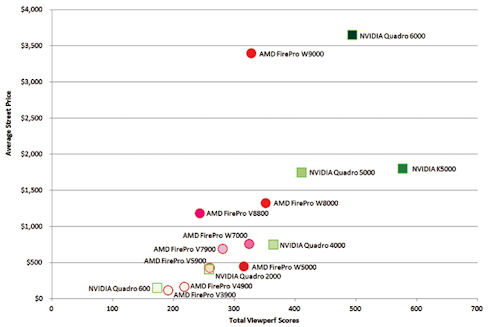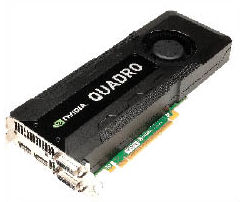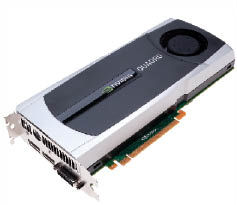NVIDIA Delivers on Price vs. Performance
The company's new Kepler-based Quadro K5000 turns in a stellar performance.
Latest News
December 4, 2001
In August 2012, NVIDIA announced its new Quadro K5000, the first Kepler-based GPU built as part of its NVIDIA Maximus platform. Maximus, which was first introduced in November 2011, enables workstation users to simultaneously perform complex analysis and visualization on a single machine. While the Quadro K5000 delivers state-of-the-art graphics performance, it can also be combined with the new NVIDIA Tesla K20 CPU computing accelerator, freeing up the new NVIDIA Quadro K5000 GPU to handle the graphics functions.
 Price/performance of current NVIDIA Quadro boards and comparable AMD FirePro boards. |
We ran the new Quadro K5000 through its paces, and also looked at the company’s other ultra-high-end Quadro 6000 board, the company’s top-of-the-line Fermi-based board.
NVIDIA Quadro K5000 Hits Price Sweet Spot
The NVIDIA Quadro K5000 is the company’s new high-end graphics solution, yet with a manufacturer’s suggested retail price (MSRP) of $2,249 and an average street price around $1,800, the K5000 delivers a lot of bang for the buck. The Quadro K5000 features 1536 compute unified device architecture (CUDA) parallel processing cores and includes 4GB of GDDR5 error correcting code (ECC) memory.
The board’s next-generation streaming multiprocessor design, called SMX, offers several important architectural changes. These include substantial increases in per-clock throughput of key graphic operations that combine to deliver unprecedented performance and power efficiency. NVIDIA claims floating point performance of 2.15 teraflops single precision and 90 gigaflops double precision. With a 256-bit memory interface and a memory bandwidth of 173GB/second, the Quadro K5000 delivers 1.8 billion triangles per second.
The new NVIDIA Kepler architecture also introduces the concept of bindless textures, which enables the GPU to reference textures directly in memory, effectively eliminating the limit on the number of unique textures that can be used to render a scene, and reducing the CPU overhead to deliver improved performance.
The Quadro K5000 provides a dual-link DVI connector, as well as two DisplayPort 1.2 connectors, which support resolutions of up to 3840x2160 at 60Hz. You can also add stereo 3D with the addition of an optional 3-pin mini-DIN. The board also accepts an optional Quadro Sync card for framelock/genlock, and the board supports SLI and SDI.
Although the K5000’s thickness means that it takes up the space of the adjacent expansion slot, this NVIDIA board has a maximum power consumption of only 122 watts, so it requires just one additional 6-pin auxiliary power connector.
NVIDIA Quadro 6000 Delivers Power
With a manufacturer’s suggested retail price of $4,999 and an average street price still holding at $3,650—more than a year after its introduction—the NVIDIA Quadro 6000 is certainly not for everyone. But for those who need a huge frame buffer coupled with lots of compute power, the Quadro 6000 certainly delivers.
The Quadro 6000 features 448 CUDA parallel processing cores and includes 6GB of GDDR5 memory. The use of ECC memory offers protection of data in memory to enhance application data integrity.
The board features a 384-bit memory interface and a memory bandwidth of 144GB/second. NVIDIA claims floating point performance of 1.03 teraflops single precision and 515 gigaflops double precision. NVIDIA’s Scalable Geometry Engine technology enables the Quadro 6000 to deliver 1.3 billion triangles per second.
Output options include a dual-link DVI connector and a pair of DisplayPorts. There’s also a built-in 3-pin stereo connector, and the Quadro 6000 also accepts an optional Quadro G-Sync card for framelock/genlock. Although all of this power results in an extra-thick board that takes up the space of the adjacent expansion slot, the Quadro 6000 has a maximum power consumption of 204 watts, so it requires either two 6-pin or one 8-pin auxiliary power connectors.
This board’s maximum digital display resolution reaches only 2560x1600 at 60Hz, but the Quadro 6000 does incorporate a Parallel DataCache with on-chip shared memory to accelerate real-time ray tracing, physics processing, and texture filtering. It also features Dual Copy Engines, which allow simultaneous transfer of data between the GPU and the host computer—further accelerating operations such as ray tracing and physical simulations.
Benchmarking the Boards
We tested both the new NVIDIA Quadro K5000 and the Quadro 6000 in an HP Z820 workstation equipped with a pair of Intel Xeon E5-2687W 3.1GHz eight-core CPUs and 32GB of memory, running the 64-bit version of Windows 7. That system supports PCIe 3.0, and its 1,125-watt power supply has more than enough capacity to meet the demands of even ultra-high-end boards.
| SPECviewperf Benchmark Results for Current NVIDIA Quadro Series Graphic Cards Reviewed | ||||||||||||||||||||||||||||||||||||||||||||||||||||||||||||||||||||||||||||||||||||||||||||||||||||||||||||||||||||||||||||||||||||||||||||||||||||||||||||||||||||||||||||||||||||||||||||||||||||||||||||||||||||||||||||||||||||||||||||||||||||||||||||
| ||||||||||||||||||||||||||||||||||||||||||||||||||||||||||||||||||||||||||||||||||||||||||||||||||||||||||||||||||||||||||||||||||||||||||||||||||||||||||||||||||||||||||||||||||||||||||||||||||||||||||||||||||||||||||||||||||||||||||||||||||||||||||||
We ran version 11 of the SPECviewperf video benchmark. We also used the HP Z820 to retest all of the other NVIDIA Quadro boards we reviewed last year, using the latest version of the NVIDIA video driver, so that we’d have a direct comparison of all of the boards.
Based on our results, the new Quadro K5000 clearly outperformed every other board we’ve ever reviewed, including the Quadro 6000. We also tested new- and previous-generation AMD FirePro graphics boards in the same HP Z820 workstation so that we could see how NVIDIA stacks up against its competition. You can make some quick comparisons in our Price/Performance chart (see page 44).
 The high-end NVIDIA Quadro K5000. Images courtesy of NVIDIA. |  The ultra-high-end NVIDIA Quadro 6000. |
Of course, like all other NVIDIA Quadro boards, the Quadro 6000 and K5000 are fully certified with most CAD and DCC applications. All of the boards in the Quadro line use the same unified video driver. Drivers are available for most 32- and 64-bit operating systems, including Windows 8, Windows 7, Windows Vista, Windows XP, Linux, Solaris and FreeBSD. NVIDIA also released a version of the Quadro K5000 for Apple Macintosh, and provides drivers for OSX Leopard (10.5.7), Snow Leopard (10.6.8), Lion (10.7.5), and Mountain Lion (10.8.2).
Clearly, NVIDIA has delivered a significant new level of performance with its new Kepler-based Quadro K5000. It will be extremely interesting to see if and when the company’s latest GPU technology trickles down to the company’s midrange and entry-level boards.
David Cohn is the technical publishing manager at 4D Technologies. He also does consulting and technical writing from his home in Bellingham, WA, and has been benchmarking PCs since 1984. He’s a contributing editor to Desktop Engineering and the author of more than a dozen books. You can contact him via email at [email protected] or visit his website at DSCohn.com.
MORE INFO
- NVIDIA Quadro K5000 MSRP: $2,249 Avg. Street Price: $1,800
- NVIDIA Quadro 6000 MSRP: $4,000 Avg. Street Price: $3,650
Subscribe to our FREE magazine, FREE email newsletters or both!
Latest News
About the Author
David Cohn is a consultant and technical writer based in Bellingham, WA, and has been benchmarking PCs since 1984. He is a Contributing Editor to Digital Engineering, the former senior content manager at 4D Technologies, and the author of more than a dozen books. Email at [email protected] or visit his website at www.dscohn.com.
Follow DERelated Topics





